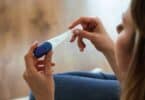
As women progress through their menstrual cycle, changes in the viscosity of cervical mucus changes. When an egg develops in one of the ovaries, estrogen spikes. This spike causes mucus released through the cervix slippery and thinner, enabling sperm to swim its way to the egg with less difficulty. Once the egg is released, testosterone levels spike and thicken the mucus, which acts as a barrier to sperm.
Interestingly enough, the method has been around for a while. But according to a recent study by the University of North Carolina at Chapel Hill, few women know about it or actually follow through with it, despite the fact that previous studies have found that women who use it are two to three times more likely to get pregnant than those that don’t.
For the University of North Caroline Chapel Hill, researchers tracked the conception results of 331 women between the ages of 30 and 45 with no known fertility issues. Each of the women had been trying to conceive for three months or less. Researchers asked them to categorize their cervical discharge as one of four types: 1) dry or nonexistent; 2) damp; 3) thick and white or yellowish; 4) transparent or slippery.
According to the researchers, despite the fact that they were asked to monitor their mucus, only about 5 percent of all women did so daily; a whopping 54 percent failed to check their mucus at all. Comparing the two groups, researchers found that the 6 percent of women who had tracked their mucus discharge consistently were 2.3 times more likely to get pregnant over a six month period than those that didn’t.
“This technique can be used to help people get pregnant faster,” Dr. Anne Steiner, an ob-gyn at the university and senior author on the study told Fox News. “It’s exciting to potentially say this is a real way to help people; it’s so cheap and easy.”
And, in many ways, the method is better than other options for women without fertility issues. Menses mapping can be inexact, even for women with regular cycles. Ovulation predictor kits can be expensive, about $20 to $40 a month. Temperature tracking is only effective for the following month. However, cervical mucus tracking enables a women to try conceiving the very same month, at absolutely no cost. It’s because of this that the study authors believe that many women are missing out on an amazing opportunity for getting pregnant.
But it might not be right for everyone.
“A lot of women may not see their cervical mucus externally,” Dr. Elizabeth Ginsburg, an ob-gyn at Brigham and Women’s Hospital in Boston, who was not involved in the study, told Fox News. “My concern is, you tell a patient to look for this type of discharge, and [if] she doesn’t see it, she may worry that she has fertility problems, when she’s probably ovulating just fine.”
However, Dr. Wendy Vitek, an ob-gyn at the University of Rochester Medical Center in New York, who was not involved in the study, told Fox News does agree with the authors; mucus tracking does hold a lot of promise for women trying to conceive.
“It makes intuitive sense that the women monitoring their cervical mucus more frequently had a better sense of when they’re ovulation…You do need to make involved observations to know when you’re at peak fertility,” she said.
To improve the chances of conception with mucus tracking, researchers on the study suggest that women observe their cervical mucus and keep a daily record of the discharge, noting which of the four categories used in the study it falls into. On the days that it’s a type 4, they say that would probably be the best time for a women to try and conceive.
Related Articles:
- Strange Pregnancy Craving Causes Severe Heart Complications and Threatens Woman’s Life
- Upcoming Genome Study Could Help Parents Learn Health Risks of a Child before Conception
- First Woman to Receive Ovarian Transplant in Australia Gives Birth to Baby!






